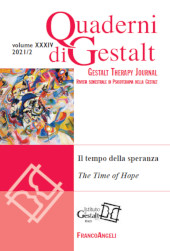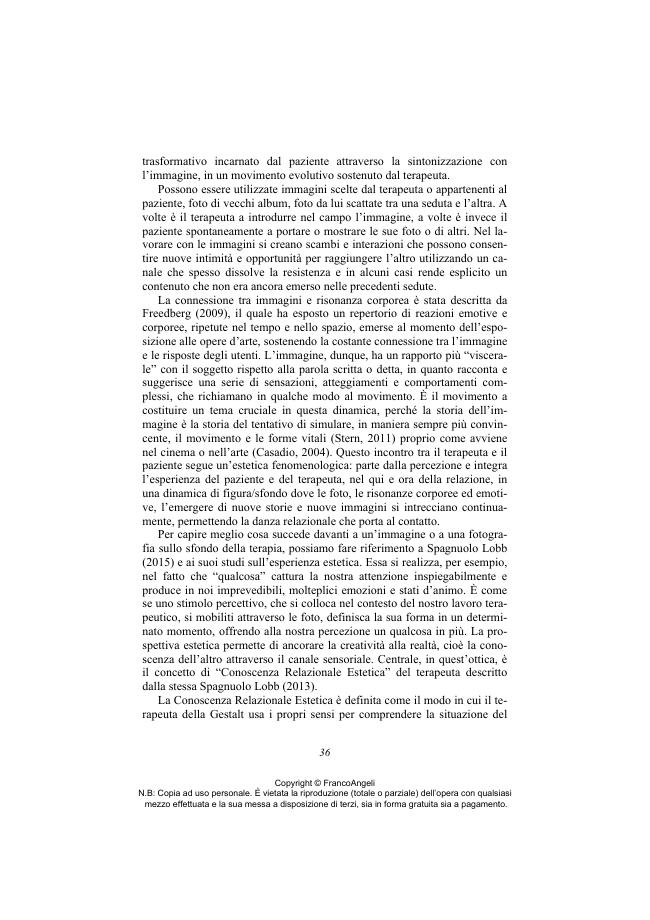L'uso delle immagini e della fotografia nella psicoterapia della Gestalt : neuroestetica, neuroni specchio e risonanza corporea
29-43 p.
La psicoterapia della Gestalt permette l'uso delle immagini e delle fotografie nel processo terapeutico in ragione della sua natura fenomenologica orientata al processo. Le fotografie diventano un mezzo che consolida la consapevolezza dei pazienti, facilitando la dinamica figura/sfondo. Questo articolo offre un excursus teorico che spazia tra la fototerapia e la psicoterapia della Gestalt, con riferimento ai capisaldi della epistemologia gestaltica come la consapevolezza, la concentrazione e la presenza ai sensi. Propone altresì una trattazione sulla correlazione tra le recenti ricerche neuroscientifiche sui neuroni specchio, il campo di indagine della neuroestetica, il concetto di conoscenza relazionale estetica e quello di risonanza corporea, come sfondo teorico alla validità dell'uso della fotografia nei processi trasformativi terapeutici. Gli autori concludono con esempi di applicazione del mezzo fotografico nel processo di terapie individuali. [Testo dell'editore].
The authors of this article highlight how various psychotherapeutic approaches use images and photographs in order to stimulate new processes and meanings in the therapeutic relationship, activating a positive evolution in the patient. Gestalt therapy, due to its phenomenological processoriented nature that emphasizes relationship and perception, allows a functional and creative use of images and photographs in the therapeutic process. In the first part of the article the authors offer a theoretical excursus on the clinical use of photographs and images that has seen a significant implementation over the years, assuming a significant value with respect to the benefits on mental health, as confirmed in the literature by psychotherapists of different orientations.
The central objective of the authors is to create a theoretical background that allows contact between phototherapy (Weiser, 1999) and Gestalt Therapy; starting from the cornerstones of Gestalt epistemology including awareness, concentration and presence of the senses, the authors discuss how, through photography, the patient can rediscover a different and creative mode of contact, capable of opening a new proprioceptive narrative path. Another objective of the authors is to highlight the correlation between recent neuroscientific research on mirror neurons, the field of investigation of neuroaesthetics, the concept of "Aesthetic Relational Knowledge" (Spagnuolo Lobb, 2013) and that of body resonance, offering a scientific framework that reinforces the validity of the use of photography in the transformative therapeutic processes in the Gestalt field.
The authors show how the connection between images and body resonance described by Freedberg (2009) can be superimposed on the clinical work carried out with the use of images in a therapeutic setting using photos chosen by the patient and shared with the therapist. Senses, perception, body, subjectivity, art and embodied emotions, central themes of neuroaesthetics, are also fundamental in the epistemology of Gestalt therapy, where on the clinical level, in the here and now of the relationship, the individual recognises himself and moves energy and intentionality towards the other. In the second part of the article, the authors offer an example of clinical application in a Gestalt psychotherapeutic setting of the images and principles of phototherapy. [Publisher's text].
-
Articles from the same issue (available individually)
-
Information
ISSN: 2035-6994
KEYWORDS
- Psicoterapia della Gestalt, fotografia, Conoscenza Relazionale Estetica, neuroscienze, risonanza corporea
- Gestalt psychotherapy, phototherapy, Aesthetic Relational Knowledge, neuroscience, body resonance



